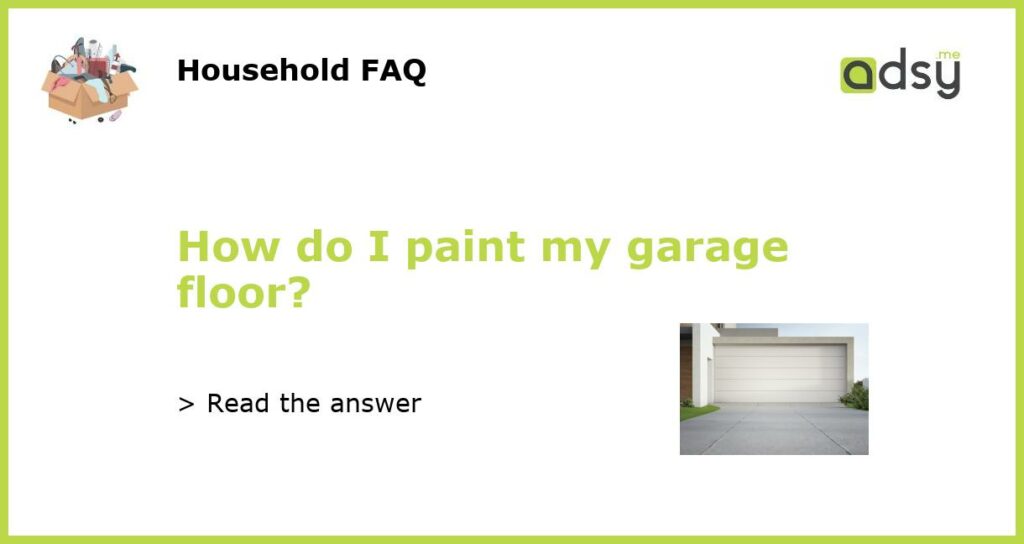Preparing the Garage Floor
Before you start painting your garage floor, there are several steps you need to take to ensure that the surface is properly prepared. First, you should clean the floor thoroughly to remove any dirt, oil, or grease. This can be done by sweeping the floor and then using a degreaser or concrete cleaner to scrub away any stubborn stains. Rinse the floor thoroughly and allow it to dry completely before proceeding.
Next, you will need to repair any cracks or imperfections in the floor. Use a concrete patching compound to fill in any holes or cracks, and allow it to dry according to the manufacturer’s instructions. Once the patching compound is dry, you can sand down any rough areas with a diamond-grit sandpaper to create a smooth surface.
After the floor has been cleaned and repaired, it is important to etch the surface to promote better adhesion of the paint. Etching can be done with a muriatic acid solution or a concrete etching product. Follow the instructions on the etching product carefully, as it can be caustic and should be handled with caution. Once the etching process is complete, thoroughly rinse the floor and allow it to dry before moving on to the next step.
Choosing the Right Garage Floor Paint
When it comes to choosing the right paint for your garage floor, there are several options to consider. Epoxy paint is a popular choice for garage floors, as it is long-lasting and durable. It is also resistant to chemicals and stains, making it ideal for a garage environment. However, epoxy paint can be more challenging to apply, as it requires mixing multiple components and following specific application instructions.
If you prefer a simpler option, there are also one-part garage floor paints available. These paints are typically acrylic-based and are easier to apply than epoxy paint. They still provide a durable finish and are resistant to chemicals and stains, but they may not be as long-lasting as epoxy paint.
In addition to choosing the right type of paint, you should also consider the color and finish. Garage floor paints are available in a variety of colors, allowing you to customize the look of your garage. When it comes to finish, a high-gloss or satin finish is usually recommended for garage floors, as it provides better resistance to stains and is easier to clean.
Applying Garage Floor Paint
Before you begin painting your garage floor, be sure to read and follow the manufacturer’s instructions for the paint you have chosen. Start by cutting in around the edges of the floor using a paintbrush or small roller. This will help create clean lines and avoid getting paint on the walls or other surfaces. Once the edges are painted, you can use a larger roller or paint sprayer to apply the paint to the rest of the floor.
Be sure to work in small, manageable sections and apply the paint evenly. If you are using epoxy paint, you may need to apply multiple coats. Follow the recommended drying time between coats, and be sure to allow the final coat to dry completely before walking or driving on the surface.
Maintaining Your Garage Floor
Once your garage floor is painted, it is important to properly maintain it to ensure it stays in good condition. Avoid dragging heavy objects across the floor, as this can scratch or chip the paint. If you need to move heavy items, use a dolly or other equipment to protect the floor.
Clean up any spills or stains as soon as possible to prevent them from penetrating the paint. Regularly sweep or vacuum the floor to remove dirt and debris, and use a mild detergent and water to mop up any stubborn stains or dirt.
Over time, your garage floor may begin to show signs of wear and tear. If this happens, you can touch up any areas that have chipped or become discolored. Simply clean the area, sand down any rough edges, and apply a fresh coat of paint. This will help extend the life of your garage floor and keep it looking its best.
Additional Tips and Considerations
Before you start painting your garage floor, there are a few additional tips and considerations to keep in mind:
- Ensure good ventilation in the garage while painting, as paint fumes can be strong. Open windows and doors, and consider using fans to circulate fresh air.
- Wear appropriate safety gear, such as gloves, goggles, and a mask, to protect yourself from any chemicals or fumes.
- Allow the paint to dry and cure fully before putting any furniture, vehicles, or other items back in the garage.
- If you are unsure about painting your garage floor yourself, consider hiring a professional contractor who specializes in garage floor coatings.
- Regularly inspect your garage floor for any signs of damage or wear, and address any issues promptly to prevent further damage.

